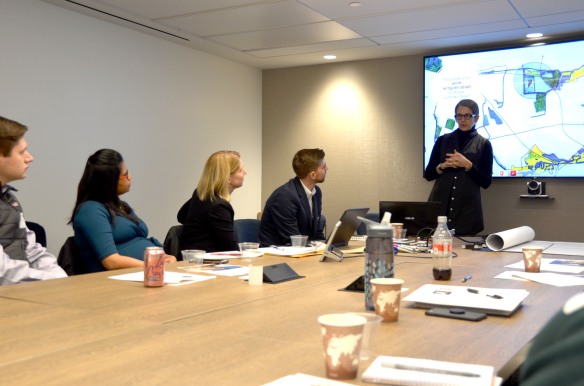Date: March 06, 2020
Location: American Geophysical Union; 2000 Florida Avenue NW, Washington, DC 20009
Led by: Andrew Bickell & Lindsay Brugger
Downloads: Session 06
In this session on Industry Trends, scholars explored the idea of resilience and how it relates to new opportunities to serve clients and communities while anticipating and designing for shocks and stresses. This session taught scholars how to analyze design strategies and use leadership skills to apply this process in a firm setting.
Activity #1 – The Business Case for Resilience
Katharine Burgess moderated a panel on climate change and real estate, identifying financial challenges and opportunities for leaders within firms. Panelists included Jessica Long with Nuveen, Jim Landau with MetLife, and Kimberly Pexton with JBG Smith. Panelists began by discussing how insurance companies utilize risk management to create resiliency standards and how architects should have the initiative to dig deeper and ask questions to investors. Developers may not be thinking about this, yet, but investors are. The future is going to get hotter, wetter, and more volatile so architects and designers are encouraged to aim for energy efficient and cross disciplinary solutions. The takeaway: financially, everything boils down to risk, and climate change is moving faster than policies and projects.

Activity #2 – Shocks and Stresses Analysis Workshop
Dr. Janice Barnes, managing partner at Climate Adaptation Partners, discussed how to identify risks and vulnerabilities of clients and how to design to meet goals for resilience. Janice began the session with the message on how to see things differently and how not to turn our heads away from vulnerability and risks. Her hashtag #wecantunknowthis encourages designers to take a problem and ask how to mitigate the vulnerabilities that are identified.
Janice led a workshop to show scholars how easy it is to identify low and high likelihood stresses as well as ranking them from low to high consequence. This activity shows how shocks and stressors can have a compounding impact. This is an easy activity to take to any firm or client to start the discussion on vulnerabilities and how to mitigate and adapt to foreseeable events. After all, climate change is not covered in the building codes.


Activity #3 – Building Tour of American Geophysical Union
Architects of the American Geophysical Union gave a guided tour to see some of the spaces showcasing the building´s energy saving systems. AGU has four net-zero strategies including generation, reduction, absorption, and reclamation. Scholars toured the command center, viewed the hydroponic wall, learned about the municipal sewer heat exchange system, and saw a portion of the storm water collection and reuse system.


Activity#4 – Calamity and Adaptation Workshop
The final activity for Industry Trends was led by Ann Kosmal. Ann began by explaining the difference between resilience and adaptation, an important distinction when discussing issues such as climate change. Ann explained the four steps of determining stages of resilience: identifying exposure, identifying the dominant factor, determining plausibility, and determining coping capabilities.
Ann stressed that architects and designers have the duty to elevate the client’s knowledge and demonstrate foreseeable risks. Designers also can discuss the cost impacts for mitigation versus revenue loss to the client.
Scholars ended the day discussing how to bring back conversations on resilience to firms and how to use leadership skills to start the conversation with clients.
